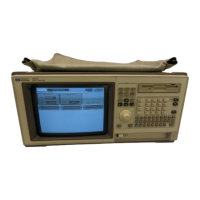Resource TestResour ce T est The pattern, range, edge, and glit ch recognizers are tested and verified.
First, the test register is verified for correct operation. Next, the pattern comparators
are tested to ensure that each bit in the recognizer memory location as well as the logic
driver/receiver are operating. The edge and glit ch pattern det ectors are t hen verified in
a similar manner. The range detectors are verified with their combinational logic to
ensure that the in- and out-of-range conditions are recognized.
Passing the resource t est implies t hat all of t he pat t ern, range, edge, and glit ch resources are
operating and that an occurrence of the pattern, edge, or glitch of interest is recognized.
Also, passing t his t est implies t hat t he range recognizers will det ect and report in- and
out-of-range acquisition data to the sequencer or storage qualifier. The drivers and receivers
at the recognizer input and output pins of the acquisition IC are also checked to be sure they
are functioning.
Sequencer TestSequencer Test The sequencer, the state machine that controls acquisition storage, is
tested by first verifying that all of the sequencer registers are operating. After the
registers are checked, the combinational logic of the storage qualification is verified.
Then, both the occurrence counter and the sequencer level counter are checked.
Passing the sequencer test implies that all 12 available sequence levels are functioning and
t hat all possible sequence level jumps can occur. Also, passing t his t est implies that
user-defined ANDing and ORing of storage qualified data patterns will occur, and that the
occurrence counter that appears at each sequence level is functioning.
Clock Gener at or TestCl ock Gener at or Test The master clock generator on the acquisition ICs is tested by
first checking the operation of the clock optimization circuit. The state acquisition clock
paths are then checked to ensure that each state clock and clock qualifier are operating
by themselves and in all possible clock and qualifier combinations. The timing
acquisition optimization circuit is then operationally verified. Finally, the timing
acquisition frequency divider (for slower timing sample rates) is checked.
Passing the clock generat or t est implies that each acquisit ion IC can generat e it s own mast er
clock whether t he clock is generated using a combinat ion of ext ernal clocking signals ( st at e
mode) or internal sample clock signals ( t iming mode) .
Data Input InspectionData Input Inspection
The data input inspection allows a user to verify that all of the data and clock/data pipelines
are operational. When the data input inspection test is selected, a test signal is fed to the
test input pins of all 9-channel comparators. The test menu displays the activity indicators
for all data and clock/data channels, which should show transitioning data signals on all
channels.
The data input inspection is not an active part of the performance verification. However, the
test is useful for identifying failed channels in order to temporarily work around the problem
unt il t he logic analyzer module can be sent to an HP service center for repair.
Theory of Operation
Analyzer Tests (Analy PV)
8–17

